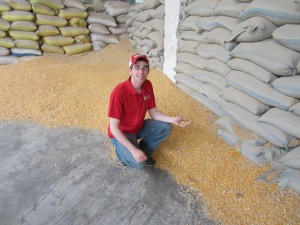By Kevin Welter
I met with my college advisor my sophomore year, and I recall her asking me if I had ever thought of studying abroad. I responded that I had never considered it. She promptly informed me of a two-week agriculture-focused study abroad trip to China in May 2013. It fulfilled a requirement to graduate, and I knew that a friend was already planning on participating as well. That was enough for me to decide to sign up, and I submitted my application for my passport soon after.
Little did I realize at the time that this class was going to be much more than a graduation requirement, but an experience of a lifetime.
The class met once a week to prepare us for the trip and to learn basic information about farming in China. I learned what to expect in China, and I prepared for international travel. The semester quickly came to an end, and it was time to board the plane for China. Anyone who has traveled abroad understands the feeling of a 13-hour plane ride. Throughout the duration of that 13-hour flight, I had a wide-ranging mixture of emotions all hitting me at once. I was nervous, excited, and tired from not getting much sleep. We finally landed in Hong Kong, and the feeling that I remember upon arrival was WOW…I’m actually in another country.
Throughout the trip we went to many tourist attractions including the Terra Cotta soldiers, the Great Wall of China, the Olympic Village, and many more amazing sights. While all these attractions were each fantastic in their own way, some of the most memorable experiences for me occurred while touring the agricultural areas of China. We toured swine, grain, beef, fish, and dairy farms. It was very interesting to see that their production agriculture has little automation. Many of these farms are starting to work with genetics from the United States and other countries as well. We also toured a feed mill that used corn and soybean meal from United States and Brazil. This is helping improve yields and efficiency of their agriculture production.
We also toured fish, meat, vegetable, and fruit markets. These markets did not appear to have any restrictions that pertained to sanitation. When walking down the street in the meat market we would see halves of hogs hanging or being pushed down the street in carts. These markets were where consumers came to purchase food for the week. After talking with our translator about the markets, we learned that the older generations prefer fresh food that they can choose themselves. These markets give the consumers what they want from the country’s farmers.
 I talked with my fellow students on the trip while riding the bus to our next destination. We were all surprised with the number of people everywhere. Not only were there swarms of people within the large cities, but in the rural communities as well. The large size of the population makes for very inexpensive labor, causing minimal automation, as the capital investments can be expensive.
I talked with my fellow students on the trip while riding the bus to our next destination. We were all surprised with the number of people everywhere. Not only were there swarms of people within the large cities, but in the rural communities as well. The large size of the population makes for very inexpensive labor, causing minimal automation, as the capital investments can be expensive.
We toured a shipping port as well as a John Deere engine works factory. In both of these businesses, human labor was used instead of making capital investments to automate some tasks.
Overall this experience gave me a broader perspective on the world as well as the vastness of farming throughout the world. China is one of the largest importers of American agricultural goods. Understanding the needs and wants of the rest of the world will continue to make the United States a leader in agriculture.
Kevin Welter is a student at the University of Minnesota and an agvocate for the Minnesota Corn Growers Association.


